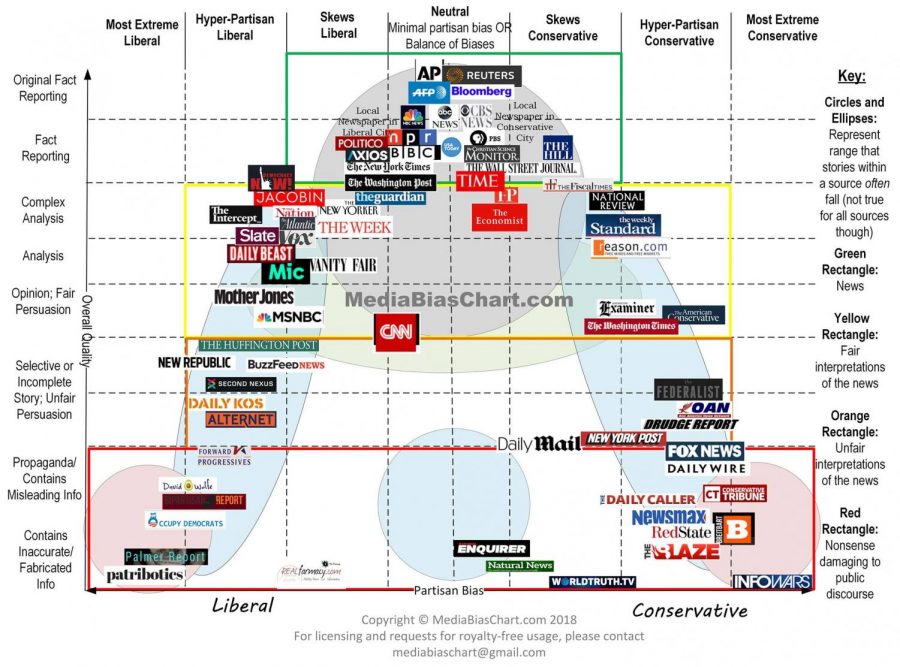Navigating the media in the era of fake news
April 30, 2019
With the growing prevalence of “fake news” in modern media it has become harder to navigate news sources. Because of this, it has been difficult to identify fake news from factual information, to evaluate news sources, and to spot reliable news sources instead of biased sources.
Penn State University Libraries defines fake news as: “Sources that intentionally fabricate information, disseminate deceptive content, or grossly distort actual news reports.” Fake news is information that is made up but is presented as reality.
“A precise definition [of fake news] is tricky, because the term ‘fake news’ has been used to describe a broad range of public and media communication artifacts, by different people, for different purposes,” said Dr. Beth Boser, Assistant Professor of Communication Studies at the University of Wisconsin-La Crosse. “In a very basic sense, it can certainly refer to stories that are factually incorrect or based upon outright lies; however, the term is also used to describe stories that misrepresent or fail to provide appropriate context for facts and events, which encourages audiences to misinterpret information and draw inaccurate conclusions.”
“Some folks like to use the term to dismiss any news that doesn’t support their own political perspective, which is, I suppose, turning the term ‘fake news’ itself into fake news,” said Boser.
Many people argue that fake news seems to be on the rise. “Because our political climate is so polarized, it has become difficult to find news that is strictly objective, which creates problems for regular people trying to find the facts and come to their own conclusions,” said Kerri Seyfert the Chairwoman for the College Republicans at UWL.
“I believe fake news has become so prevalent today is because the media decided to shed its veneer of intellectual objectivity in favor of activist journalism,” said Zachary Baklund the Communications Director for the College Republicans.
“Fake news has become more prevalent because it is now so much easier to spread disinformation through the internet,” said Adam Vlach the President of the College Democrats at UWL. “It was only a matter of time until people started to weaponize that to pursue their own agendas. Donald Trump has appropriated ‘fake news’ as a way to attack any media that disagrees with him or calls out his corrupt administration, and so people should not confuse his version of ‘fake news’ with reality.”
Deciphering fake news can be extremely difficult, especially with news going to media consumers through social media, news apps, television, newspapers, magazines, and other mediums. The News Literacy Project provides many resources for evaluating news sources, including a checklist of red flags that includes things such as excessive punctuation, emotional reaction, and the date of publication.
“I think what makes a source reliable is if it comes from citing multiple eye witness reports or reaches out and receives comment on any incident from both parties uninterrupted, without editing their responses,” said Baklund.
“Credible stories are backed up by good evidence and provide facts and context such that audiences can understand and make informed judgements,” said Boser. “Whether a source is reliable, overall, depends on the professional standards that guide its reporting. A reliable source will make their standards and ethical codes public. At the same time, citizen journalists who are not affiliated with major publications are not automatically unreliable. Sometimes more digging is required, on the part of the reader or the audience, to determine the reliability of a story.”
Just because a source is a major publication, though, doesn’t necessarily mean that it’s reliable. “It’s important to be conscious of the bias of the news source because Fox News is going to defend Trump no matter what and Huffington Post is going to come from a more liberal perspective,” said Vlach. “People should avoid getting all of their news from social media, as people tend to spread news that is more sensational and maybe not accurate.”
Both Boser and Vlach recommend The Washington Post and The New York Times as reliable news sources. Baklund said, “Local news sources are a lot more prudent in their reporting than national news networks are. It seems that the less connected the reporters are individually the less they care to reliably fact check sources without omitting context of the conversation.”
“Media literacy is important because our democracy cannot properly function if we do not have a population that is well informed on the issues,” said Vlach.
“Media literacy is fundamental to democracy. We need to be informed about issues that impact our lives, and the lives of others, in order to engage in public life,” said Boser. “Media literacy skills are necessary for us to be able to fulfill our responsibility to be engaged citizens. Beyond the importance of assessing the reliability of news sources, we need to be able to critically assess a full range of media representations – and the mechanisms by which they are produced – to understand their consequences.”








John Silva • May 1, 2019 at 9:00 am
If you disregard an entire news organization because of perceived bias, then you are allowing your own confirmation biases to influence your news and information. Instead, understand the standards of quality journalism and how to differentiate news and opinion. Then you can be open to being informed from more news sources and you’ll be more of a critical consumer of news and information instead of a cynical one.